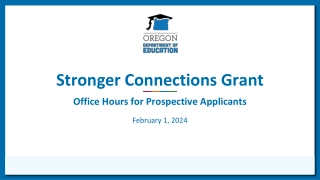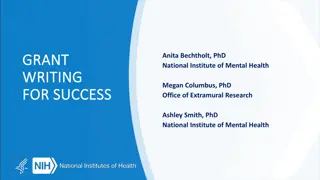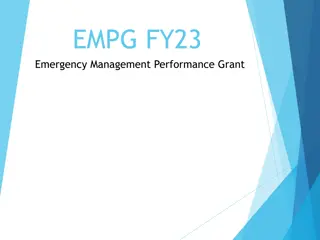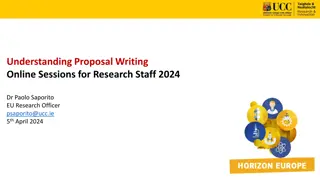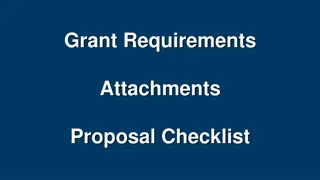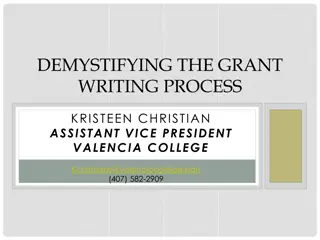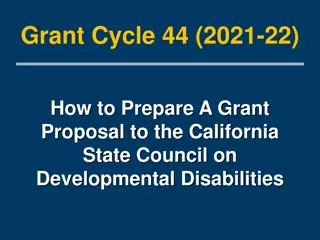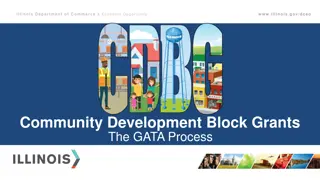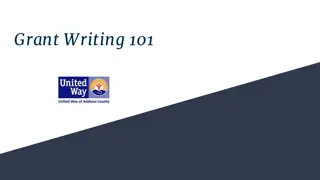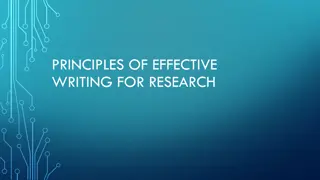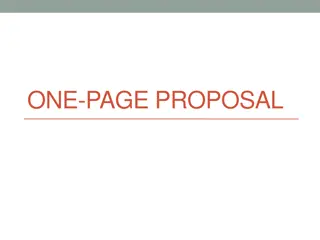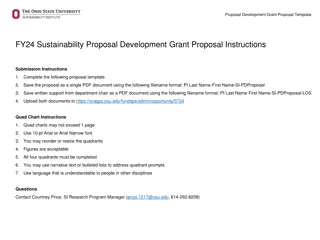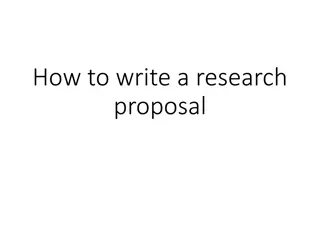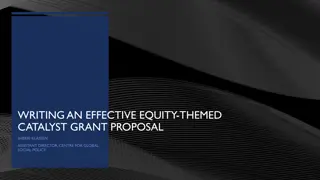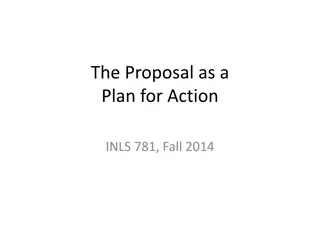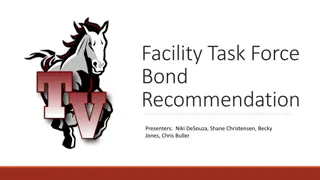
Crafting Successful Grant Proposals: A Comprehensive Guide
Understanding the intricacies of grant proposal writing is crucial for securing funding in the competitive landscape. This proposal provides valuable insights on finding grant money, improving chances of success, aligning with funders' priorities, and maximizing impact. Embrace the mindset required to navigate the grant application process effectively.
Download Presentation

Please find below an Image/Link to download the presentation.
The content on the website is provided AS IS for your information and personal use only. It may not be sold, licensed, or shared on other websites without obtaining consent from the author. If you encounter any issues during the download, it is possible that the publisher has removed the file from their server.
You are allowed to download the files provided on this website for personal or commercial use, subject to the condition that they are used lawfully. All files are the property of their respective owners.
The content on the website is provided AS IS for your information and personal use only. It may not be sold, licensed, or shared on other websites without obtaining consent from the author.
E N D
Presentation Transcript
Writing Research Proposal for a Grant Jerry O. Ugwuanyi, PhD (Strathclyde) Department of Microbiology University of Nigeria, Nsukka 1
Looking to spend somebodys money: What is it all about? You must be considering /have considered one or all of these questions: How do I find grant money to do an important work? What are my chances of getting a grant? Do I have to know the 'right people' in order to get a grant? How big a grant can I reasonably seek? How hard is it to get a grant? Should I talk to grant-makers before submitting a proposal? What do grant-makers look for in a proposal? Why would anybody spend his money on this work that I want to do? And many more related or unrelated questions Then: Is it all really worth it? If your answer to this last question is YES, then you are set to start. YOU HAVE THE RIGHT MINDSET! Remember- It is rare to be sought out on self recognition. So you have to beg (and begging comes with troubles and pains!) 2
Reasons for proposing? As a budget! -To secure funding (GRANT) For Higher Research- Masters, Doctoral, Postdoctoral or Institutional For Employment (Measuring Responsibility & Accountability) For Institutional Reviews Proposals are written in future tense 3
Grant Makers Irrespective of source: (Public or Private) grant makers seek to fill a gap between what is & what ought to be . Grant making is an attempt by funder to address gaps in his/ her/ their (own) world view. Once you can help a funder fill this gap, you already qualify to be funded (provided that nobody has asked for the same money, or less, to solve the same problem in a better way!)- COMPETITION A proposal should attempt to understand the funder s world- view on the issue and express that view convincingly. The proposal should attempt to reflect the "priorities" of the funder. Often, (and in error) grant applicants focus on their own need for funds instead of the funders priorities and need for answers. IN A CONFLICT OF EGO, LET THE FUNDER WIN 4
Grant Makers Whatever you think . Remember, it is NOT your money; you are asking .. ..as are several other people. Beggars are not (always) Choosers! 5
Grant maker: Why Should He (not) Pay? An excellent proposal will not be funded if it does not accord with a funder s short, medium or long term interest! The best proposal may not receive funding if the proposer is known to nobody; You must show that you are competent A very good proposal may not be funded Somebody has requested to do same or better for less A good question was asked badly A good concept was poorly marketed
What is a Proposal? A proposal is a codified description of an intended project or program. It is an outline that describes in clear terms -the values, aim, procedures, expected outcomes, costs, time-lines & timeliness of a project work or solution set. A reader should be able to decipher why anybody would want to spend time & money on a project from reading the proposal. The value to be added must be obvious from the proposal: -It should be SMART to pass first screen Specific; Measurable; Attainable (Achievable); Realistic; Timely (& time-bound). The best proposal for a project is one that would make a reviewer wish he had thought of it earlier 7
Is this a good proposal? Opening Questions What is it that I want to do or study? What does this project hope to accomplish? What problem do I want to solve? Do project personnel (I) have the necessary expertise to accomplish the goals? (How does the reviewer know?) Will the result achieve funder objectives? Is the project (outcome) cost effective? How good is the fund management plan? Do I come across as frugal, prudent? (The funder knows the costs!) Are the evaluation, dissemination & sustainability plans convincing? Now you have asked all the questions (the answers are .YES) you want to propose .. 8
Main Components Proposals have three main component What is to be done? Why it should be done? No matter the call structures How will it be done? In between there will be several related or derivative, questions and issues that may include these and more What is known? Who will do what? When? For how much? What are the evaluation mechanisms? What are the dissemination mechanisms? What happens after you have delivered all the results you promised?- This is called sustainability plan Remember to ask yourself: What is in it for the FUNDER? 9
Getting Started - Title An attractive title will be compelling; to ensure first reading of what you have to say: (compare ) ?? A multi-year field evaluation of the effects of development of new oil fields on mangrove forests in seasonal and permanent swamps in Nigeria s Niger Delta OK. A 3-year study of the impact of development of new oil fields on mangrove regeneration and survival in Nigeria s Niger Delta swamps ?? Evaluation of fishery potential of Anambra basin of Nigeria OK. Full-year In-stream evaluation of fresh water fish population dynamics in Obina River in the Anambra Basin of Nigeria If the title is not specific/ attractive/ crisp you have already made a bad first impression: If you are in doubt please have somebody read it! 10
Title Guides Does your prospective funder have any specifications for the Title/Cover Page? (If yes, ensure you follow it). Is the title clear, unambiguous? Remember that the title is a micro-abstract (there can be no better abstract than your project title). Avoid any word that does not improve communication Try to ensure single sentence title. If it gets difficult try use of colon and semi-colon for linkages as last resort. Are all the parties, including collaborators mentioned in the cover? If you forget to mention funder in cover, forget the grant Does your cover look professional without being fancy? Make sure you do not come across as profligate or given to fancifulness at the expense of substance. 11
Overview / Executive Summary Funder may require a Project Overview or an Executive Summary the person shortlisting may have only enough time to read the Overview - not the entire proposal. So, be specific / concise. Do not go into details that are clarified at a later point in your proposal. .so what do you want captured here? If the reader or primary evaluator is unable to find in the executive summary answers to all questions or enough reasons to believe they exist in the body, your proposal may not be shortlisted for detailed evaluation. 12
Overview/Executive Summary The Project Overview should "paint a picture" of your proposal in the mind of the reader. It should establish the framework around which the rest of the write-up revolves. It will help if the Key concerns of the funding organization can be briefly identified in relation to your proposed project. If you will be collaborating try to link in the competences of such collaborators. The best time to prepare the Project Overview is after you have completed the entire proposal and you understand the story. NOW THAT YOU KNOW THE STORY..TELL IT 13
Overview/Executive Summary Remember that someone will be reviewing your proposal and you would like this person to be very positive about what you have written. The Project Overview is the place to impress the reviewer. Work on your Project Overview so that you can avoid giving the reviewer an opportunity to say things like: Not an original idea Rationale is weak Writing is vague Uncertain outcomes Does not have relevant experience Problem is not important Proposal is unfocused Project is too large Rejection! 14
Project Body; What is to be done? The first steps in deciding this question are: What is known about the question I want to address? What are the gaps in knowledge that I want to fill? Are these gaps compelling enough to deserve funding? Is my presentation of the knowledge gap compelling? How will filling the gaps improve the final picture: value addition; knowledge, wealth creation, peace, gender, environment, trans-disciplinary & collaboration, etc.? Novelty? Is the answer you seek to provide already in the public domain anywhere? If yes, then don t ask for funding! 15
What is to be done?..... Novelty In deciding on the novelty of what you propose, how do you situate your proposal: An entirely new idea? Solution to new/ old problem? A better solution to a well known problem? Cheaper, faster, eco-friendly procedure, gender sensitive, politically correct, etc.? A trans-disciplinary procedure with new better insight and greater sustainability? 16
Background/Statement of Problems This is a review of Relevant Literature. Show the funders that you know what you are proposing; you are familiar with what has preceded you. If you worked in this area and have result be careful to show that without sounding redundant: -Is the new project expanding on some good preliminary results? Be careful in your use of language. It can be very helpful to have somebody who is not familiar with the proposal to read it and minimize use of: Jargon; trendy or "in" words; abbreviations; colloquial expressions; redundant phrases; confusing language Position your project in relation to other efforts and show how your project: a) will extend the work that has been previously done, b) will avoid the mistakes and/or errors that have been previously made, c) will serve to develop stronger collaboration between existing initiatives, or c) is unique since it does not follow the same path as previously followed. 17
Background / Statement of Problems contd. Show that your proposed project is definitely needed and should be funded (timely for the problem). What are the pressing problems that you want to address? How do you know these problems are important? What other sources/programs similarly support these needs as major needs? How will your project help the funding agency in fulfilling their own goals and objectives. Keep the funding agency in mind as a cooperating partner committed to the same concerns that you have. Is there a special reason why you and/or your organization are uniquely suited to conduct the project? Geographic location, language expertise, prior involvements, close relationship to the project clientele, etc.) Have you worked with your collaborators before? If not what is the guarantee that the collaboration will work (MOU? Personal Knowledge? Expertise? Commitment?) Tell your most compelling and memorable story here. It is the marketing section of a solicitation document 18
Problem statement..nutshell Your statement of the problem---represents the reason behind your proposal. The problem statement specifies the conditions you wish to change. It should be supported by evidence drawn from experience, authoritative statistics & appropriate literature. It should quickly summarize the problem, show your familiarity with prior work on the topic, reinforce your credibility, and justify why this problem should be investigated. Do not assume that everyone sees the problem as clearly as you do. Even if the problem is obvious, your reviewers want to know how clearly you can state it. 19
Some Key sectional questions + Does your problem statement 1. Demonstrate precise understanding of the problem that you are attempting to solve? 2. Clearly convey the focus of your project early in the narrative? 3. Indicate the relationship of your project to a larger set of problems or issues and justify why your particular focus has been chosen? 4. Establish the importance and significance of the problem? 5. Justify why your problem should be of special interest to the sponsor? 6. Demonstrate that the problem is feasible to solve? 7. Make the reviewer want to read further? 8. Indicate how the problem relates to your organizational goals? 9. State the problem and outputs in terms of human needs and societal benefits? 10. Answer sustainability question? Remember: If it is not a problem, don t solve it! ..So avoid little is known about...", "there is a lack of information about...", or "no research has dealt with..." If it is not worrying anyone else then it is unlikely to worry the funder! 20
Objectives Statement Try to differentiate between your goals & your objectives but include both. Goals are the large statements of what you hope to accomplish but usually are not very measurable. They create the setting for what you are proposing. Objectives are operational, tell specific things you will be accomplishing in your project, and are very measurable. Objectives will form the basis for the activities of your project and will also serve as the basis for evaluation. Your proposal is easier for a prospective funder to understand (and the outcomes are clearer) if you describe your objectives in measurable ways. 21
Objectives Statement contd. Insure that there is considerable overlap between the goals & objectives for your proposal and the goals & objectives of the funding organization. Include specific information about the population or clientele (immediate or long term beneficiaries) on which your project is focused. IMPORTANT! Who else is funding? Be sure to clarify why it is important for the funding organization to be concerned about your clientele. Your proposal should clearly indicate how assisting your clientele is in the best interests of the funding organization. 22
Objectives statement- Basic guide AS a general guide, keep it SIMPLE Specific--indicate precisely what you intend to change through your project. Immediate make solving this problem urgent and provide time frame. Measurable- What is the proof of project success? Practical-how is each objective a real solution to a real problem. Logical- indicate how each objective systematically contributes to achieving your overall goal(s). Evaluable- indicate how much change has to occur for the project to be effective (mixable with M). These categories are not mutually exclusive, but ensure that each of your objectives meet at least two or three of these six criteria. 23
Some Key sectional questions + Does your objectives statement 1. Clearly describe your project's objectives, hypotheses, and/or research questions? 2. Signal the project's objectives in a lean mass of narrative? 3. Demonstrate that your objectives are important, significant, and timely? 4. Comprehensively describe the intended (& measurable) outcomes of the project? 5. State your objectives, hypotheses, or questions in a way that they can be evaluated or tested later? (NOT PERISHABLE!) 6. Demonstrate why your project's outcome is appropriate and important to the sponsor? List your specific objectives in no more than one or two sentences each in approximate order of importance & progression. A good objective emphasizes what will be done and when it will be done 24
Methods Statement This section describes project activities, .how the objectives will be accomplished. It should include sequence, flow & interrelationship of activities. Ensure there is a clear link between methods and objectives. Emphasise how the method will elicit clear solutions to identified problem. Are there any innovations or possibilities of innovating? Funders will like to see what new, unique or innovative actions you are proposing. Is the method unique or standard to make success probable or certain? Make this obvious. 25
Methods Statement contd. Emphasise any method that will uniquely benefit the target- immediate or long-term beneficiaries. Do not forget to include the collaborative relationships your project will develop with other co-operating groups and the value they bring. How will the methods you propose encourage trans- disciplinary collaboration. Disciplines are no longer independent. Remember, wherever possible, make society, gender or environment important! Emphasise the value of the methods for sustainability beyond the life of the project (This can tie into your Dissemination Plan.) If there is institutional project sustainability plan indicate so & bring to the fore! 26
Some Key Sectional questions + If applicable, does your method statement : 1. Explain why you chose one methodological approach and not another? 2. Describe major activities for reaching each objective? 3. Indicate the key project personnel who will carry out each activity? 4. Show the interrelationship among project activities? 5. Identify all project data that will be collected for use in evaluating project outcomes? If a method is not published or standard be sure to offer convincing explanation as to why it must be used Remember: Funders rarely provide a checklist for this section. So PROVIDE YOUR OWN If you are in doubt . Begin with your objectives . Describe what precise steps you will follow to carry out each obj.. Include what will be done. 27
NEVER FORGET Once you have determined the sequence of events you will follow in completing your project, cast the major milestones into a time-task chart. called a GANTT Chart (illustrative project scheduling: -Karol Adamiecki, 1896 & Henry Gantt, 1910) In graphic form, it segments the project into manageable steps It lets your reviewers know exactly what you will be doing and when. It says to the reviewers that you are organized and have thought out the major steps of your project. It lets them know you have done significant planning and are not just proposing on a whim. It gives a road map of what you plan to cover. Finally, the time-and-task chart represents a clear, one-page, visual summary of the entire methodology section. If it is not specifically prohibited ensure you include this-- requested or not Note: NOT ALL FUNDERS REQUEST IT; BUT ALL FUNDERS LOOK FOR IT 28
DISSEMINATION AND PUBLICITY THIS MAY BE ALL THE FUNDER GETS FROM YOUR WORK & FOR ALL HIS MONEY. LET IT GET 51% OF YOUR TROUBLE; THE FUNDER WILL BE HAPPY TO KNOW! The more open and willing you are to help others learn from your experiences the more likely a funding agency will be interested in paying. Consider including in your proposal additional funds for hosting some form of workshop or institute where you can bring together other professionals who are interested in conducting a similar project in their area. This would be a good way to publicly recognize your funding organization. Invite funder to such activity so they can hear what others think about the investment they have made. How will you be sharing information about your project with others? Will your project include a Newsletter; Posters, Fliers etc.? How about a website/ page in your institutional website? HELP THEM TO BLOW THEIR TRUMPET 29
For DisseminationRemember. Dissemination is the means by which you let others know about your project. It is critical b/c it generates publicity for YOUR SPONSOR and you. Indicate why dissemination activities are important to the project Clearly identify the intended outcome of dissemination effort Include a feasible and appropriate plan for dissemination Describe any products resulting from the dissemination effort 30
For DisseminationRemember. Demonstrate that you are well grounded in theory and research on the dissemination and utilization of knowledge Provide sufficient detail on proposed dissemination procedures to justify the budget request Specify who will be responsible for dissemination & their capacity Indicate why dissemination will get the necessary information to the appropriate audiences in a form they can use when needed Will dissemination activate action for further intervention (including by other parties)? 31
Will Evaluation be Needed? It is important to describe exactly how you will decide whether or not your project has been successful. Evaluations pinpoint what is really happening in your project so you can improve your project efficiency. Based on evaluation information, you can better allocate resources, improve your services, and strengthen your overall project performance. An Evaluation Plan will tell the funders how you will be showing at the end of the project that the investment in you was a good one 32
Contd.Will Evaluation be Needed? If evaluation is needed let the process Describe why evaluation is needed in the project Identify the purpose of your evaluation & the audiences to be served by the results Demonstrate that an evaluation procedure is included for every project objective Provide a general organizational plan or model for your evaluation Demonstrate that the scope of the evaluation is appropriate to the project Demonstrate the extent to which the project is practical, relevant, and generalizable Describe what information will be needed to complete the evaluation, potential sources for this information, and the instruments that will be used for its collection Clearly summarize any reports to be provided to the funding source based on the evaluation, and generally describe their content and timing 33
Evaluation Process In designing an evaluation process; irrespective of whether you or a professional will implement, ask yourself: What will be evaluated? What information will be needed to conduct the evaluation? Where the information will be obtained? How often data will be collected? Data collection instruments to be used? What evaluation design will be used? What analyses will be completed? What questions you will be able to answer as a result of the evaluation? 34
Evaluation Process Evaluation is essentially a four-step process. If your objectives & methodology are precise, evaluation is a straightforward process: What will be evaluated. If you wrote measurable objectives, you already know what to evaluate.- in the objective of proposal Methods you will use to evaluate each objective. You will need to describe the information you need and how you propose to collect it. In the methods Complete your evaluation design. Specify the analyses you plan to make & carry out evaluation by collecting and interpreting the data needed for each objective. Your evaluation design may be simply to observe the behaviour of a particular population or something more complex like a rigorous experimental and multiple control group design. Summarize the resulting data analyses and indicate its use. Consider including mock data tables that show what your resulting data might look like. Funders want to see statistics and significance. Be sure to analyse your data effectively 35
Evaluation bits If you plan to use a survey or questionnaire for evaluation, you may want to include a draft of this in the Appendices. Your evaluation plan does not have to be elaborate but it is important to indicate that you have not forgotten this important step. Try to include both a concern for formative evaluation/process evaluation (ways to gain feedback on the project while it is being conducted) and summative evaluation/product evaluation (ways to show that the project fulfilled that which was originally proposed). Make direct reference to your objectives in your evaluation plan. This creates a strong sense of integration/ consistency within your proposal. Your evaluation plan should include some sense of concern for what goes on following the conclusion of the funding period. THIS IS SUSTAINABILITY How will the initiatives that have been started under the project be sustained? Have new things occurred that will be continued in the future? How will other cooperating agencies including your employer assist in continuing the project after the conclusion of the funding period? 36
Money matter.Budgeting Budget is a mathematical rendition of your entire project It is more than just a statement of proposed expenditures It is an alternate way of expressing your project. Programs officers will look at your budget to see how well it fits your proposed activities. Incomplete budgets signal sloppy preparation. Inflated budgets are signals, at best of waste; or at worst of questionable credibility. If you come from corruption endemic area? If in addition you are not known to the funding agency???? Budgets that are too low cast doubt, at best on your planning ability; or at worst your capacity. Your budget is at the very least as much a credibility statement as your project narrative. Sequence budget items as you would a gantt chart to indicate period of project associated with given cost. Can the funding be phased? If yes, go for it. It convinces funder about your commitment 37
Money matter.Budgeting If you are a first timer or you are not sure .. Talk to somebody! Make your budget realistic. Carefully think through exactly what you will need from the funder to carry out the project and establish your budget around this amount. (Remember: funding agencies are more experienced in funding than researchers! They can easily tell when someone has inflated a budget in order to procure funds for other purposes.) Check with the funder to see if they have suggested/required budget categories. If there is none then you may consider organizing your budget around a set of meaningful fundable categories such as: Personnel (salary/ benefits), fringe benefits, dues, Consultants (salary)- accountant, legal service, Instruction, Tuition Equipment, maintenance, insurance Supplies, periodicals, books, research animals Communication (telephone/postage) Materials preparation, computer time, Services, binding, audio visual, radio, television, advertising Travel, Rental of facilities, transport Evaluation, Dissemination, publication, Other expenses- will you host anybody; hospitality, refreshment (clearly specify this & never use Miscellaneous) Indirect or Administrative costs (organizational -rent, renovation, municipal services, security) Provide researched estimate for any request and never leave room for doubts In theory anything may be funded .. In practice you must be very careful what to include 38
Budget Some Important questions Does your budget address these question? Provide sufficient resources to carry out your project? Include a budget narrative that justifies major budget categories? Present the budget in the format desired by the funder? Provide sufficient detail so the reviewer can understand how various budget items were calculated? Separate direct costs from indirect costs and describe what is covered in the latter? Relate budget items to project objectives? Include any attachments or special appendixes to justify unusual requests? Identify evaluation cost? Provide for dissemination costs? Did you mention cost sharing, matching grant or sustainability support? Is your organisation contributing? - cash or kind? this is good news if you properly articulate it! 39 Think if you were the one paying!
Sundry Issues Staff/Administration Use this section to describe the roles of the different people associated with your project and the importance of each. Make sure to clarify how each of the roles are essential to the success of the project and how each role clearly relates to operationalizing the methods you have described. Make sure you include name, title, experience, and qualifications. Include other information if you feel it is important to the success of your project. The descriptions of your personnel should let the funding agency know that you have excellent people who are committed to the project. You are not asking the funding agency to "trust" you. The validity of what you are proposing is directly related to the people who will work on the project. Working together as a part of a team is something that funding agencies often like to see. Try making your project a team effort. 40
Sundry Issues Available Resources/ Facilities Collaborative efforts are usually considered very favourably! Many funding agencies like to see cooperative ventures as the basis for action. In other words, the funding agency's money is being brought together with other existing organizations that are already committed and involved in dealing with the needs that the project is responding to. Sometimes local resources go unnoticed. Look carefully around you because there are certain to be resources that you have available that you may not be noticing (volunteers, materials that local merchants may provide, local experts who can provide help/advise when needed, meeting rooms, library space, etc.). Such in- kind resources can show a potential funding agency that you are strongly rooted in your community. It is very impressive to a prospective funding agency if local resources have already been contacted and plans to include them in the project have already been made. Letters from local resources supporting the project are an excellent addition to the proposal. Be careful in listing the equipment that will be needed for your project. Funding sources are usually much more willing to provide funds for the support of personnel than they are to support the purchase of equipment (that may or may not directly benefit the funded project). 41
Must Watch Miscellaneous Logistics Entertainment Page numbering ?? Submission time-line What about writing a draft proposal when there is no call? This enables you to take your time . Then tailor the proposal when you see a call 42
THANK YOU The End 43

